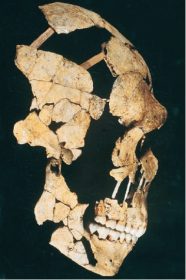Neandertals made their appearance midway through the 19th century, at a critical moment in intellectual history, when old but comfortable ideas about the human past were beginning to fall apart and new but shocking ideas (such as evolution) were coming in. The old ideas did not explain Neandertals. The new ones, which could, were generally poorly understood. Therefore, no one was prepared for the sight of a primitive-looking skeleton in the human closet. But when such a skeleton appeared in Germany in 1856, in the Neander Valley (or Neandertal in old German), it brought on a sense of denial to its connection to Homo sapiens. The workmen, who had blasted open a small cave in their search for limestone, never realized the significance of their find.
 Neandertals and present-day Homo sapiens, although they have many similarities, have significant anatomical differences. Neandertals lived 100,000 to 35,000 years ago and are considered by many to be a direct relative of modern humans. Over the past two decades, new analyses of fossil remains and sophisticated models have shown greater anatomical differences between humans and the Neandertals. The Neandertal’s bone and ligament size are much greater and thicker than ours. Their arm, leg, shoulder, and even finger bones were very thick and durable to deal with their harsh conditions. These findings have also led to new conclusions concerning the behavior of Neandertals, such as their ability to care for the sick and weak, and also the possibility of aggression within the species itself, both of which are modern human qualities. Neandertal’s place in human evolution has been both strengthened and weakened by this relatively new information.
Neandertals and present-day Homo sapiens, although they have many similarities, have significant anatomical differences. Neandertals lived 100,000 to 35,000 years ago and are considered by many to be a direct relative of modern humans. Over the past two decades, new analyses of fossil remains and sophisticated models have shown greater anatomical differences between humans and the Neandertals. The Neandertal’s bone and ligament size are much greater and thicker than ours. Their arm, leg, shoulder, and even finger bones were very thick and durable to deal with their harsh conditions. These findings have also led to new conclusions concerning the behavior of Neandertals, such as their ability to care for the sick and weak, and also the possibility of aggression within the species itself, both of which are modern human qualities. Neandertal’s place in human evolution has been both strengthened and weakened by this relatively new information.
All muscles that go from the shoulder blade to the upper end of the arm demonstrate massive development in the Neandertals, particularly the muscles responsible for powerful downward movements of the arm and muscles that stabilized vigorous shoulder movements. Because the skeleton must be capable of supporting increased levels of stress within its environment that are frequently several times as great as body weight, the enlarged attachments for muscles and ligaments are associated with leg bone shafts that have been reinforced. The shafts of all of the arm and leg bones are tubular structures that have to absorb stress from bending and twisting without fracturing. The Neandertal’s ligament surface area was also greater than a modern human’s, therefore effectively reducing the force per square unit of pressure on its joints and cartilage to deal with increased levels of stress.
Between 1953 and 1960, anthropologist Ralph Solecki of Columbia University excavated a series of partial skeletons from Shanidar Cave in northern Iraq. From studies on these skeletons by Dale Stewart, an anthropologist at the Smithsonian Institute, and Erik Tinkhaus, they discovered that several of the skeletons showed signs of trauma during their life. The left ninth rib of the skeleton at Shanidar 3 showed a partially healed wound by a sharp object. The position of the wound on the rib, the angle of incision, and the cleanliness of the cut make it unlikely that the injury was inflicted accidentally. It appears exactly like a wound inflicted by a right-handed adversary in face-to-face combat. Many finds from the Neander Valley, La Chapelle, and La Quina have all shown signs of trauma, but the interesting fact lies in that, despite these traumas, the Shanidars did not die until they were somewhere between 40 and 60 years old, providing evidence that individuals were taken care of long after their economic usefulness to the social group ceased.
Neandertals, therefore, are anatomically quite different from modern humans, but behaviorally, they show many similarities. Neandertal limbs and ligaments were tougher, thicker, and stronger than our own to deal with the harsher conditions they faced, such as hunting and defense from predators. Their arms, fingers, and legs were able to handle increased levels of stress, showing they led very active lives. Behaviorally, however, a Neandertal was quite similar to Homo sapiens. Signs of trauma, perhaps caused by other Neandertals, were found at Shanidar Cave, revealing aggression much like that of our own species today. The fact that some of the Neandertals lived to a relatively old age, despite these traumas, details their ability to care for the injured or weak long after their usefulness to the group ended, just as we do today. Neandertals are a key link in human evolution, and many of our modern traits can be discovered in this species. Perhaps with time, we will discover that we have even more similarities with them.
References:
- Brace, C. L. (1964). The fate of the “classic” Neandertals: A consideration of hominid catastrophism. Current Anthropology, 5(1), 3-43.
- Eiseley, L. (1957). Neandertal man and the dawn of human paleontology. Quarterly Review of Biology, 32(4), 323-329.
- Solecki, R. S. (1971). Shanidar: The first flower people. New York: Knopf.
- Trinkaus, E. (1978). Hard times among the Neandertals. Natural History, 87, 58-63.

